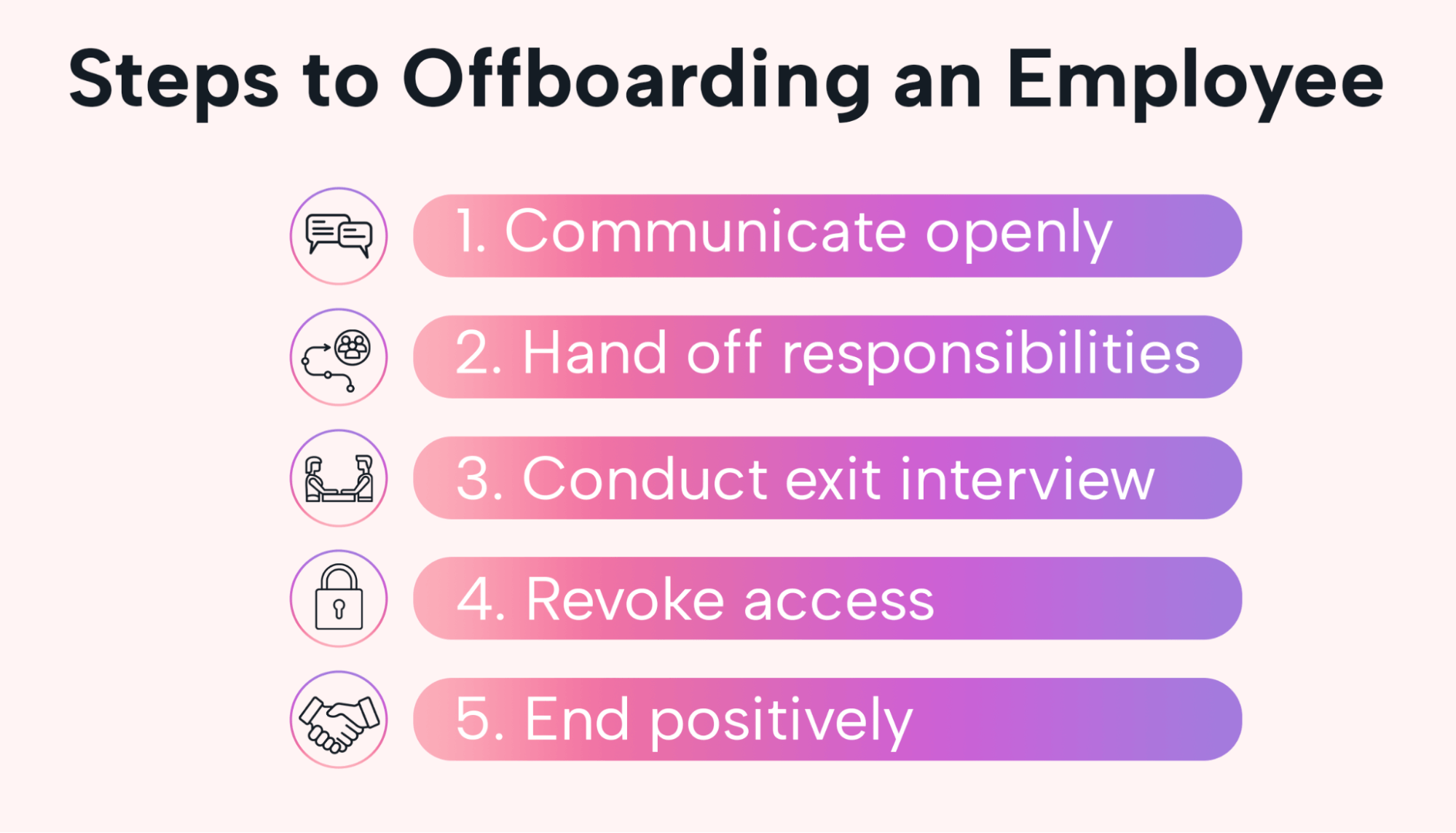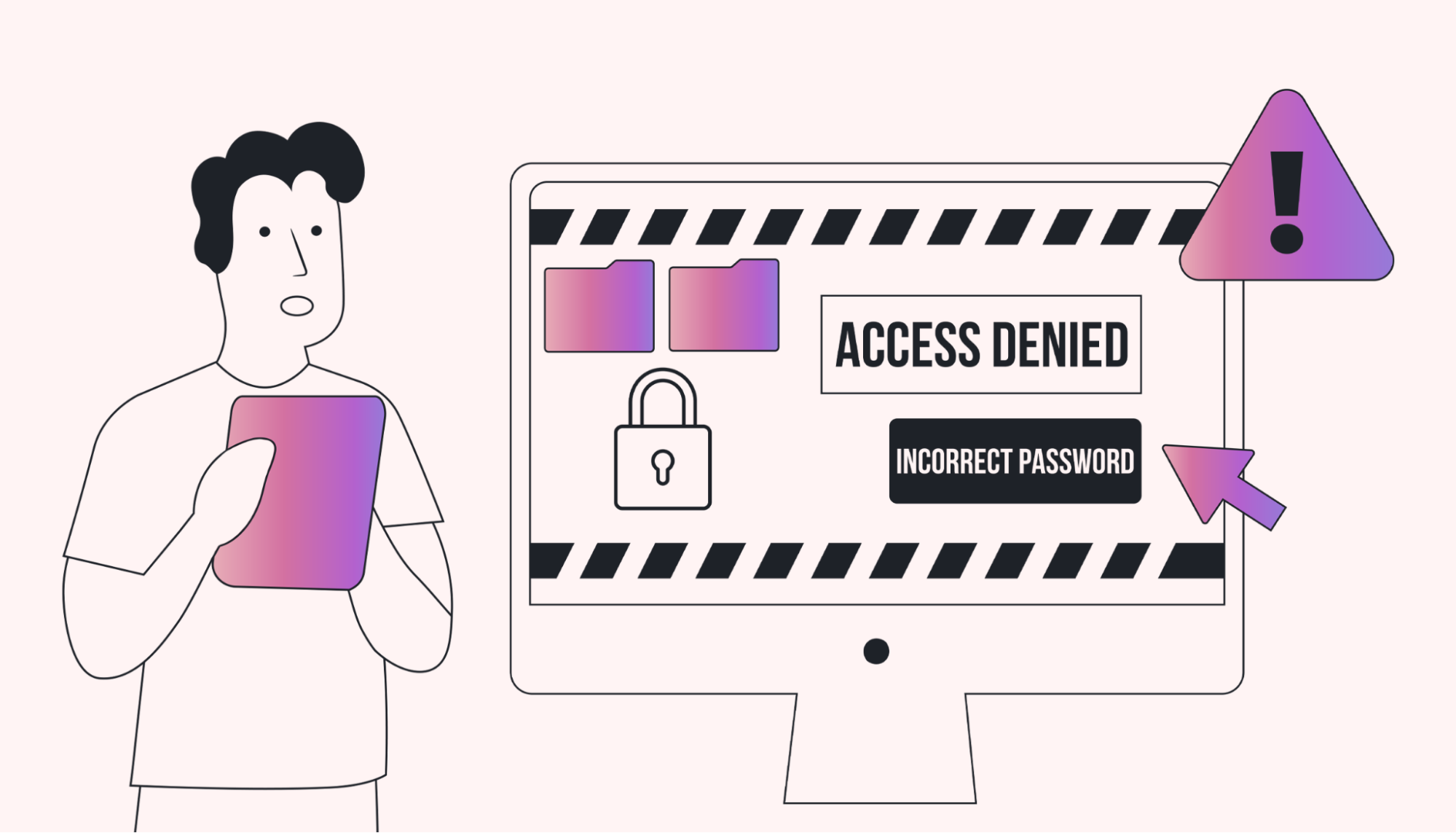It’s not easy to lose an employee.
You have to worry about whether your data is secure, your project timelines can be upheld, and you can preserve company knowledge.
There’s also the potential legal fallout and effects on the company’s reputation.
But that’s where the art of offboarding comes in.
Fortunately, a powerful offboarding process can help you mitigate these and other problems.
In this article, we explain offboarding in clear language. We tell you the benefits and best practices and guide you through a step-by-step offboarding checklist.
With this knowledge in hand, you can make offboarding part of your strategy for success.
What is offboarding?
Every team member within an organization has a unique journey. Each phase is marked by distinct processes — processes that are hopefully done well.
Many are familiar with “onboarding” — the welcoming phase for recruits. Offboarding is the closing phase. And while it’s not generally given the care and attention onboarding gets, it’s still a critical component of the employee journey.
Offboarding is a structured process that guides the transition of an outgoing employee.
Though someone is leaving your organization, it’s important to avoid thinking of this moment as an administrative task or routine goodbye. Effective offboarding creates an opportunity out of a loss.
Many actions are common to the offboarding process, including the following:
- Tying up loose ends in the worker’s employment
- Conducting an exit interview
- Completing paperwork
But offboarding is more than just the typical tasks it involves. It’s a strategy to reinforce the foundational principles the company stands by.
 |
Whether the departure is due to resignation, retirement, or something else entirely, the goal is the same — to ensure the departing employee’s transition is:
- Smooth
- Dignified
- Comprehensive
After all, this is the organization’s final gesture of goodwill. It demonstrates their commitment to the employee, even as their time with the company concludes. This last impression can become a lasting impression on the departing employee as well as remaining staff.
Consider a team member who resigns. Imagine if HR barely responded to this news other than to have them fill out a form. Or worse, if there was no clear process for handing over their tasks.
There’d be a flurry of messages on the employee’s last day. The remaining employees could still be scrambling to catch up and cover their bases weeks later.
If done wrong, thoughtless offboarding results in:
- A negative perception by the departing employee
- A strain on the remaining staff
- Decreased productivity and morale
That’s why you need a thoughtful, structured approach to offboarding.
The benefits of an effective offboarding process
Turnover is a fact of life. In fact, the average employee turnover rate in the United States is 17.3%, so it’s a given that workers will always be coming and going.
Here are the benefits of handling the offboarding process well:
Protects company data and assets
In the digital age, each employee exit poses potential risks. Unstructured exits can leave data and company assets vulnerable.
Such vulnerabilities can be catastrophic if overlooked.
According to a 2023 DTEX report, 12% of employees take sensitive data with them after leaving an employer.
That can include:
- Company data
- Employee data
- Client data
An organized offboarding process mitigates these risks by ensuring digital footprints are addressed quickly.
Maintains brand image
Every departing employee carries with them a story about their experience with the company. This means they can become either brand ambassadors or harsh critics.
For a positive relationship departure, the offboarding process should be respectful, structured, and hospitable. This can lead to:
- Positive testimonials
- Referrals to a friend
- Future re-collaborations
Reinforces company culture
Abrupt departures can disrupt team dynamics and diminish employee morale.
On the other hand, a well-executed offboarding process sends a clear message to current employees, as it shows that the organization values each employee’s contributions right until the end. Such actions reinforce the company’s core values and demonstrate commitment. As a result, the remaining staff can feel secure in the integrity of their company.
Collects valuable feedback
The exit interview is a cornerstone of the offboarding process. But it’s more than just a formality — it’s a golden opportunity to gain honest feedback from someone with intimate experience of the organization.
Employees on the cusp of leaving typically feel free from workplace politics or the fear of facing repercussions. That openness provides invaluable insights into the following:
- Areas for improvement
- Potential pitfalls
- Internal perception of the company
- Opportunities for growth
Offboarding checklist: A step-by-step guide
As we’ve discussed, offboarding is a crucial moment in an employee’s lifecycle. Follow the steps below to ensure your company reaps the benefits of offboarding well.
 |
Step 1: Communicate openly
The first step to an employee’s departure is clear, honest communication.
That means sharing the news promptly and addressing the reasons behind the departure. It’s also an opportunity to set the tone for the process ahead.
Transparent discussions not only ensure that the departing employee is aware of what to expect, but they also reassure the remaining team members — minimizing the potential for rumors and helping to ensure the transition is smooth.
Step 2: Hand off responsibilities
Next, address ongoing projects and any affected processes.
The responsibilities of the departing employee must be systematically handed over to another team member. That usually involves mentorship sessions during which the outgoing individual briefs their successor on the following:
- Info about ongoing projects
- Any relevant deadlines
- Potential challenges
It’s also crucial to keep all stakeholders and collaborators in the loop about the change. That way, seamless collaboration can continue.
The goal of this step is to minimize disruption and make sure no project is left hanging or unattended.
Step 3: Conduct an exit interview
This step is critical and can lead to a treasure trove of insights.
It is a unique opportunity to tap into the departing employee’s candid perspective. It’s a chance to understand the root causes of their departure.
Your goal during this interview is to gather feedback about:
- Team dynamics
- Management practices
- The workplace environment
For example, an employee’s letter of resignation might state that their reason for leaving was “a better opportunity elsewhere.”
However, after the exit interview, the company might learn the employee was frustrated by a lack of training and that poor communication between management and staff led to stressful deadlines.
Through these valuable insights, the company can learn of their weak spots and tighten up operations for the benefit of the rest of the staff.
Step 4: Revoke access
Security is paramount in today’s digital age. As an employee exits, it’s crucial to guarantee they no longer have access to company property, data, or tools.
 |
Start this process with digital checkpoints where you revoke the following:
- Email access
- Subscriptions to software tools
- Cloud storage
- Access to any other digital platforms
Next, be sure any physical assets, such as key cards or company equipment, are returned.
Account for all client contact information to be sure no unauthorized contact occurs in the future.
Think of this step as a systematic lockdown to ensure the departing individual has no lingering access to company assets or data after their departure.
Step 5: End positively
The end of an employee’s time at a company is often an emotional journey for them. Therefore, it’s important to wrap up the final stages of offboarding in a dignified, respectful manner.
Openly discuss — and promptly settle — any pending payments, benefits, or entitlements.
Also, consider a small farewell gesture to acknowledge the contributions of the departing member. Examples include the following:
- A staff gathering
- A token of appreciation
- A simple card
Remember, today’s employee might be tomorrow’s partner, client, or brand ambassador. Always keep that door open and part ways with them amicably.
Best practices in offboarding
Now that you know each step of the offboarding process, let’s deepen that understanding with the following vital tips:
Maximize feedback
Exit interviews have become standard practice for many companies. But the real value lies in what you do after the interview.
Hearing is one thing, but your goal is to really listen. And, of course, to then act.
So, tap into the concerns and deficiencies discussed in the exit interview and work to resolve the issue.
For example, if multiple departing employees complain about a rigid mindset toward flexible work, it may be time to address ways to better the employee experience and find a middle-ground solution.
Integrate technology
It’s no surprise that there are specific software and tools for your offboarding process.
HR software can simplify and streamline the offboarding journey. Some of these tools can automate tasks such as:
- Revoking accounts
- Collecting feedback
- Storing records of past offboarding
The right tools don’t just simplify the offboarding process — they also make sure it’s thorough, consistent, and well-documented for future needs.
Maintaining alumni relations
Lay the foundation for lasting business relationships. One way to facilitate that is through alumni networks or groups.
These platforms serve as a bridge that keeps past employees connected to the company. A sustained connection benefits both parties.
The company stands to gain from referrals and future partnerships, and alumni are plugged into a network that can help them in future endeavors.
Legal and ethical guidelines in offboarding
Laws vary, of course, but wherever you operate, there are legal compliance and ethical considerations during offboarding. Here are three aspects to be aware of:
1. Contractual obligations
Each employment contract carries specific legal obligations.
Companies must know and respect these terms during offboarding. This could involve:
- Non-compete clauses
- Upholding confidentiality
- Final compensation agreements
It’s wise to consult a local employment attorney to take stock of any local laws that could intersect with offboarding.
The US Department of Labor website also has comprehensive information about employment laws.
2. The balance between data protection and respect
Protecting company data is vital, but it shouldn’t come at the expense of the departing member’s dignity.
 |
Revoke access to email and company systems while considering the employee. Inform them of the timing of these steps — and the reasons why they’re important.
The balance between protecting the company and respecting the employee can be a fine line to walk. But it ultimately comes down to transparent, respectful communication.
3. Ethical offboarding standards
Building off the last point, ethical offboarding recognizes the departing team members’ contributions and worth.
Rather than seeking to immediately cut ties, provide any necessary support during the transition.
It may be appropriate to offer:
- Career counseling
- References
- Outplacement services
Such an approach ensures the departing employee feels valued and respected. It also sets a positive precedent for both current and future staff.
Debunking offboarding myths
We hope by now we’ve cleared up any misunderstandings you might have had about offboarding. But the following three myths are worth tackling head-on before we conclude:
Myth #1: Offboarding is a one-size-fits-all process
There’s no exact formula for offboarding. Companies are different, and employees are different — and so are the circumstances behind departures.
For the exit of a C-suite executive, the process could focus on transitioning key responsibilities and transferring knowledge. Offboarding an entry-level worker, on the other hand, may allow for a more general approach.
Tailoring the process to the individual and the situation creates a smooth transition.
Myth #2: Offboarding is just a formality
Far from being a forced set of procedures, offboarding can make or break an operation.
Employee tenure is, on average, about four years in the United States.
As employees come and go, your operation can slowly damage its reputation, cause problems to go unresolved, and become vulnerable to legal situations and security risks.
Or it can use offboarding to create long-term growth and stability.
In other words, offboarding isn’t just about completing a checklist — it’s also about securing the company’s future by learning from its past and present.
Myth #3: Offboarding is a negative experience
This final myth is an especially persistent one.
We tend to think of goodbyes as a negative. But we want to remind you that offboarding represents a powerful opportunity for your company.
In fact, that employee might be back sooner than you think. Twenty percent of employees who left their employers during the Great Resignation have already returned to them.
Offboarding with care and intention will keep many positive possibilities on your horizon.
Refine your offboarding with Motion
We hope that our thorough breakdown of the offboarding process has you ready to harness your organization’s potential.
Motion is a powerful AI software that can streamline many functions of your offboarding journey. Our software has tools for:
- Project management
- Task management
- Advanced calendars
Motion is a great all-in-one tool for everyday use. Try it for free today!





